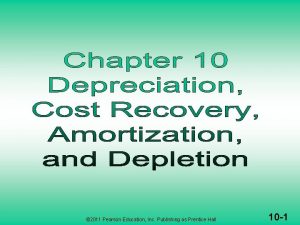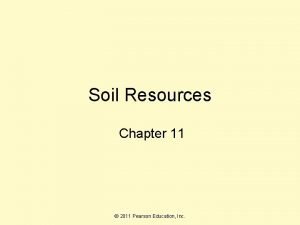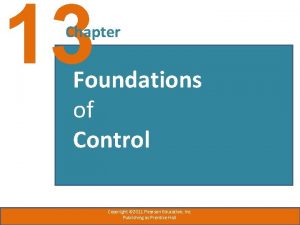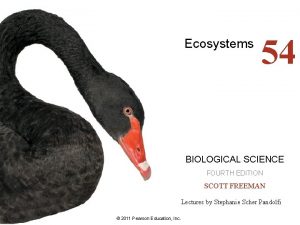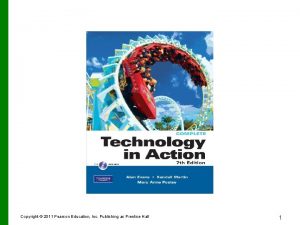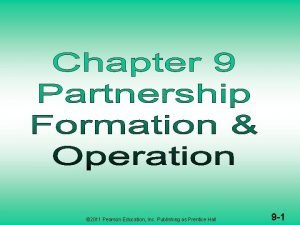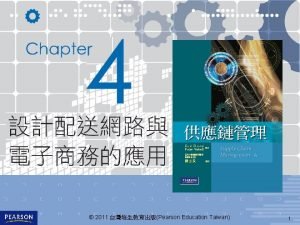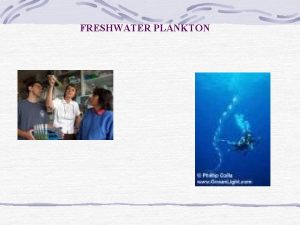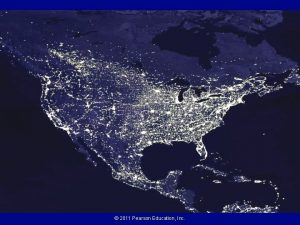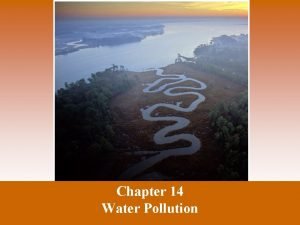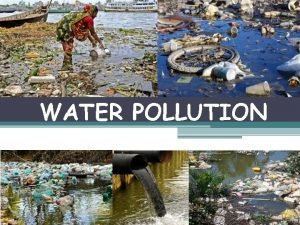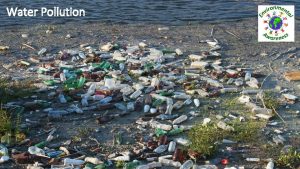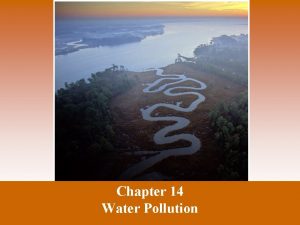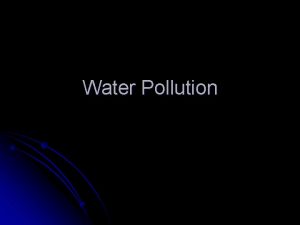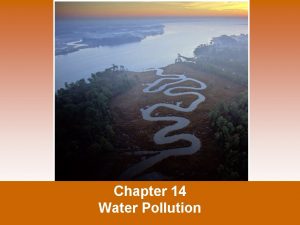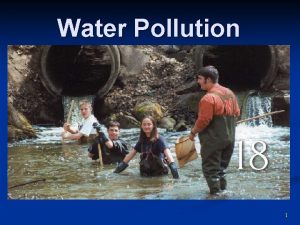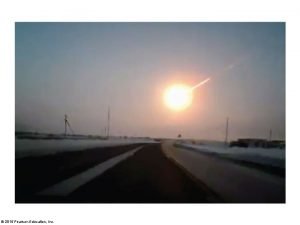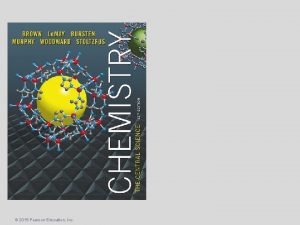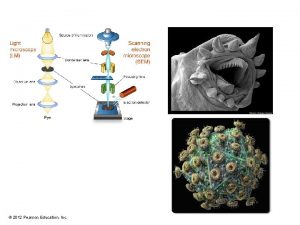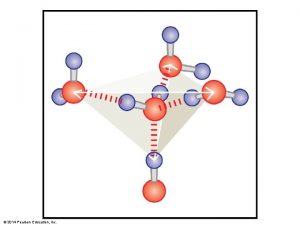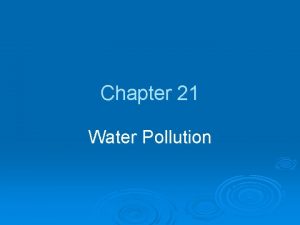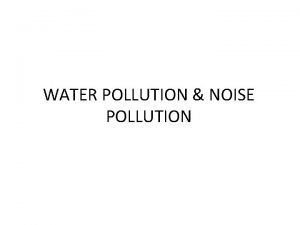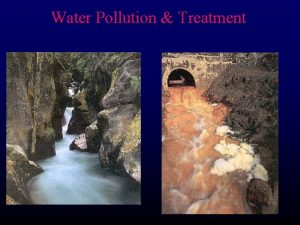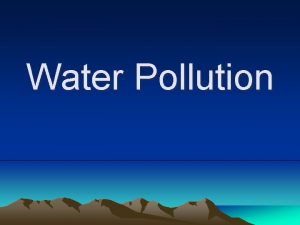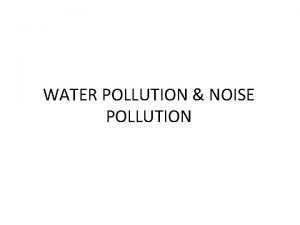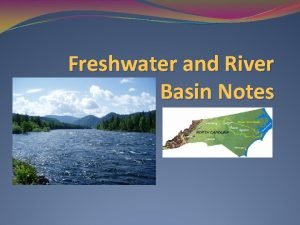Water Pollution 2011 Pearson Education Inc Freshwater pollution
























- Slides: 24

Water Pollution © 2011 Pearson Education, Inc.

Freshwater pollution and its control • Water for human consumption and other organisms needs to be: - Disease-free - Nontoxic • Half of the world’s major rivers are seriously depleted and polluted - They poison surrounding ecosystems - Threatening the health and livelihood of people • The invisible pollution of groundwater has been called a “covert crisis” © 2011 Pearson Education, Inc.

Point and nonpoint sources of pollution • Pollution = the release of matter or energy that causes undesirable impacts on the health and well-being of humans or other organisms • Point sources = discrete locations of water pollution - Factories, sewer pipes - Addressed by the U. S. Clean Water Act • Nonpoint sources = pollution arises from multiple inputs over larger areas (farms, city streets, neighborhoods) - The major source of U. S. water pollution © 2011 Pearson Education, Inc.

Freshwater pollution sources © 2011 Pearson Education, Inc.

Nutrient pollution • Nutrient pollution from fertilizers, farms, sewage, lawns, golf courses leads to eutrophication - Fertilizers add phosphorus to water, which boosts algal and aquatic plant growth - Spreading algae cover the surface, decreasing sunlight - Bacteria eat dead algae, reducing dissolved oxygen - Fish and shellfish die • Solutions include treating wastewater - Reducing fertilizer application - Using phosphate-free detergents - Planting vegetation to increase nutrient uptake © 2011 Pearson Education, Inc.

Eutrophication is a natural process, but… • Human activities dramatically increase the rate at which it occurs © 2011 Pearson Education, Inc.

Pathogens and waterborne diseases • Enter water supplies through inadequately treated human waste and animal waste from feedlots • Fecal coliform bacteria indicate fecal contamination - They are not pathogenic organisms - But the water may also hold other disease-causing pathogens (e. g. , giardiasis, typhoid, hepatitis A) • Bacterial pollution causes more human health problems than any other type of water pollution - Conditions are improving - 86% of people now have safe water © 2011 Pearson Education, Inc.

Pathogens cause human health problems • 1 billion are still without safe water • 2. 6 billion have inadequate sewer or sanitary facilities - Mostly rural Asians and Africans • Health impacts kill 5 million people per year • Solutions: - Disinfect drinking water - Treat sewage - Public education to encourage personal hygiene - Government enforcement of regulations protecting food © 2011 Pearson Education, Inc.

Toxic chemicals • Pesticides, petroleum products, synthetic chemicals - Arsenic, lead, mercury, acid rain, acid drainage from mines • Effects include poisoned animals and plants, altered aquatic ecosystems, and decreased human health • Solutions: - Issue and enforce more stringent regulations of industry - Modify industrial processes - Modify our purchasing decisions © 2011 Pearson Education, Inc.

Sediment pollution • Sediment in rivers can impair aquatic ecosystems • Clear-cutting, mining, clearing land for housing, and cultivating farm fields expose soil to erosion • It dramatically changes aquatic habitats - Fish may not survive • Solutions: - Better management of farms and forests - Avoid large-scale disturbance of vegetation © 2011 Pearson Education, Inc.

Thermal pollution • Water that is too warm causes problems - Warmer water holds less oxygen - Dissolved oxygen decreases as temperature increases - Industrial cooling heats water - Removing streamside cover raises water temperature • Water that is too cold also causes problems - Water at the bottom of reservoirs behind dams is colder - When water is released, downstream water temperatures drop suddenly, killing aquatic organisms © 2011 Pearson Education, Inc.

Indicators of water quality • Scientists measure properties of water to characterize its quality - Biological indicators: presence of fecal coliform bacteria, disease-causing organisms, algae, etc. - Chemical indicators: nutrient concentrations, p. H, taste, odor, hardness, dissolved oxygen - Physical indicators: color, temperature, turbidity © 2011 Pearson Education, Inc.

Groundwater pollution is a difficult problem • Groundwater is increasingly contaminated - But is hidden from view and difficult to monitor - “Out of sight, out of mind” • Groundwater pollution is hard to address - It retains contaminants for decades and longer - It takes longer for contaminants to break down because of lower sunlight, microbes, and dissolved oxygen © 2011 Pearson Education, Inc.

Sources of groundwater pollution • Some toxic chemicals occur naturally - Aluminum, fluoride, sulfates • Pollution from human causes wastes leach through soils - Pathogens enter through improperly designed wells - Leaking underground storage and septic tanks © 2011 Pearson Education, Inc. So far, the EPA has cleaned up 388, 000 leaking tanks

Agriculture and industry pollute groundwater • Agricultural pollution comes from several sources - Pesticides are in most of the shallow aquifers tested - Nitrates from fertilizers have caused cancer, miscarriages, and “blue-baby” syndrome - Pathogens like Escherichia coli (E. coli) • Manufacturing industries and military sites have been heavy polluters - By-products seep into water from miles around - Radioactive wastes will contaminate water for 750, 000 years © 2011 Pearson Education, Inc.

It is best to prevent pollution • It is far better to prevent pollution than use “end-of-pipe” treatment and cleanup • Other options are not as good: - Removing just one herbicide from water in the U. S. Midwest costs $400 million/year - Pumping, treating, and re-injecting it takes too long • Consumers can purchase sustainably made products - Become involved in local “riverwatch” projects - Urge government to pursue policies to fight pollution © 2011 Pearson Education, Inc.

Legislative efforts reduce pollution • Water pollution was worse decades ago - Citizen activism and government response resulted in legislation during the 1960 s and 1970 s - The situation is much better now • The Federal Water Pollution Control Act (1972) - Renamed the Clean Water Act in 1977 - It is illegal to discharge pollution without a permit - Sets standards for industrial wastewater - Funded sewage treatment plants © 2011 Pearson Education, Inc.

Enforcement of water quality is decreasing • Underfunded and understaffed state and federal regulatory agencies were pressured by industries and politicians • Violations of the Clean Water Act have risen to over 100, 000 documented violations/year - 10% of Americans are unknowingly exposed to unsafe drinking water - The new EPA administrator has promised to improve • Citizens pushed politicians to improve the Great Lakes - The water quality of the lakes has dramatically improved © 2011 Pearson Education, Inc.

We treat our drinking water • Technology and government regulation have improved our pollution control - Treated drinking water is widespread and successful in developed nations • Before water reaches the user, it is chemically treated, filtered, and disinfected • The EPA sets standards for over 90 drinking water contaminants - Local governments and private water suppliers must meet these standards © 2011 Pearson Education, Inc.

We treat our wastewater • Wastewater = water people have used in some way - Household, manufacturing, stormwater runoff, etc. - It is treated before being released into the environment • Septic systems = the most popular method of wastewater disposal in rural areas - Underground septic tanks separate solids and oils from wastewater - The water drains into a drain field, where microbes decompose the pollutants - Solid waste is periodically pumped out and landfilled © 2011 Pearson Education, Inc.

Municipal sewer systems • In populated areas, sewer systems carry wastewater to treatment locations • Primary treatment = physically removes contaminants in settling tanks (clarifiers) • Secondary treatment = water is stirred and aerated - Aerobic bacteria degrade organic pollutants - Water treated with chlorine (and/or ultraviolet light) is piped into rivers or the ocean • Reclaimed water is used for lawns, irrigation, or industry © 2011 Pearson Education, Inc.

A typical wastewater treatment facility • Sludge = solid material resulting from treatment - Is decomposed microbially - Then landfilled, incinerated, or used as fertilizer on cropland • Methane-rich gas created by decomposition can be burned to generate electricity © 2011 Pearson Education, Inc.

Artificial wetlands clean wastewater • After primary treatment at a conventional facility - Water is pumped into the wetland - Microbes decompose the remaining pollutants • Cleansed water is released into waterways - Or percolates underground • They are havens for wildlife and areas for human recreation The U. S. has over 500 artificially constructed or restored wetlands © 2011 Pearson Education, Inc.

Conclusion • Obtaining future supplies of freshwater requires citizen action, legislation and regulation, technology, economic incentives, and education • With expanding population and increasing water usage, we are approaching conditions of widespread scarcity • Water pollution is already harming health, economies, and societies of both rich and poor nations • Better regulation has improved water quality in the U. S. and other developed nations © 2011 Pearson Education, Inc.
 2011 pearson education inc
2011 pearson education inc 2011 pearson education inc
2011 pearson education inc 2011 pearson education inc
2011 pearson education inc 2011 pearson education inc
2011 pearson education inc 2011 pearson education inc
2011 pearson education inc 2011 pearson education inc
2011 pearson education inc 2011 pearson education inc
2011 pearson education inc 2011 pearson education inc
2011 pearson education inc 2011 pearson education inc
2011 pearson education inc 2011 pearson education inc
2011 pearson education inc 2011 pearson education inc
2011 pearson education inc Pearson education, inc. publishing as prentice hall
Pearson education, inc. publishing as prentice hall Pearson education 2011
Pearson education 2011 2011 pearson education inc biology
2011 pearson education inc biology 2011 pearson education inc
2011 pearson education inc Chegg
Chegg 2011 pearson education inc
2011 pearson education inc 2011 pearson education inc
2011 pearson education inc 2011 pearson education inc
2011 pearson education inc Pearson education inc publishing as pearson prentice hall
Pearson education inc publishing as pearson prentice hall Pearson education inc. 2012
Pearson education inc. 2012 Pearson education inc publishing as pearson prentice hall
Pearson education inc publishing as pearson prentice hall Pearson education 2011
Pearson education 2011 Water and water and water water
Water and water and water water 2018 pearson education inc
2018 pearson education inc












